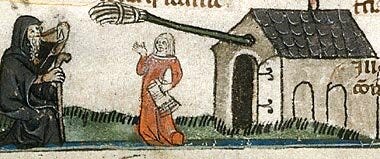In my novel-in-progress, I tell the stories of a medieval brewster, Margaret Surteys, and her step-granddaughter, Agnes.
What’s a brewster, you ask? Most women, as it turns out, until well into the Modern Era, when brewing in England and most of Europe became almost exclusively the province of men.
For millennia, brewing ale was just one of the multitude of tasks that fell under “women’s work.” In Europe, ale was the most common drink for the peasant class – the 90% for whom wine was too expensive or not available at all. It was less likely to make you sick than what came out of local streams and rivers, where folk dumped dead animals, human waste, and all manner of unsavory things. Ale was safer, as well as easy and relatively cheap to produce in small quantities, with equipment common to most households. But it did not keep well for many days, so had to be produced locally.
Enter the goodwife. In medieval villages like the fictitious Thornham, in which Margaret lived and worked, women brewed ale for their families. Many would trade or sell any surplus ale to neighbors and friends, along with wool, garden produce, eggs, or anything else they produced or gathered. Women who did this somewhat regularly were known as brewsters.
Judith M. Bennett wrote the definitive book on the subject, Ale, Beer, and Brewsters in England: Women’s Work in a Changing World (Oxford University Press, 1996). In it, she describes the state of ale-brewing in England, before and after the bubonic plague (the Black Death) killed around half the population in 1348-49. She argues that various post-pandemic economic and social factors contributed to a shift toward industrial-scale brewing, first of ale and later of beer. An industry controlled by men.
The shift was gradual, and what we know of its impact on women brewsters in villages and towns comes almost entirely from local court records. In England, ale production and sale was controlled by the Assize of Ale, a system that set maximum prices for specific quantities of ale. Violate those, and the Aletaster would have you up in the local court, where fines and other punishments (like the dreaded cucking stool) were levied.
Despite this parchment trail, we know relatively little about the day-to-day lives of ordinary folk, including the specifics of how women were gradually shut out of brewing. We do know that people drank a lot more ale after the Black Death, so demand increased. We know that alehouses began to become more common, and that women operated them primarily out their homes, and that this left them open to all sorts of dangers and a fair amount of suspicion (and worse) from church and state, as well as from their neighbors.
And that’s where we find Margaret and Agnes, working around or confronting the powerful men that expected to control their lives and livelihoods during this uncertain age.
Check back here for updates, and for other interesting bits of history related to the novel. Or, better yet, subscribe for free and get them delivered right to your inbox!





And the cucking stool was outlawed in New Jersey in 1972!!! (See Wikipedia. Tried to post an image, but I can’t in the comments)